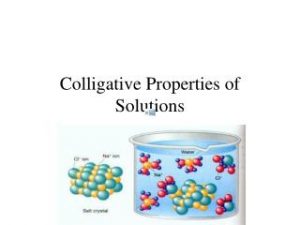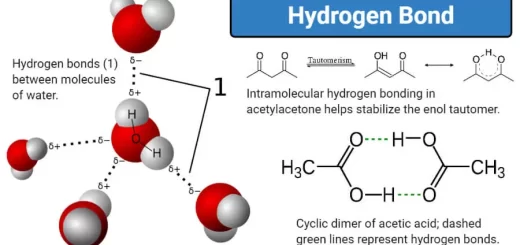Colligative ( Collective ) properties of Solutions
The properties of solutions differ from the properties of the pure solvents forming them after dissolving a non–volatile substances at the same conditions , these new properties are called Colligative properties .
Colligative ( Collective ) properties of solutions
They are properties whose values depend only on the number of solute particles per unit volume of solution and not on the type of solute , Collective properties of solutions are vapour pressure depression , boiling point elevation and freezing point depression .
Vapour pressure depression
When a pure liquid is left in an open beaker , It evaporates completely , But , when it is in a closed container , both liquid and vapour are present .
Vaporization and condensation occur , at equilibrium , the vaporization rate is equal to the condensation rate and the pressure exerted by this vapor is called Vapor pressure .
Vapor pressure is the pressure that vapor effects on the liquid surface , when the vapor is at a dynamic equilibrium with its liquid inside a closed container at a constant temperature and pressure .
The vapor pressure of a pure solvent is affected by dissolving a non-volatile solute in it to form a solution as follows :
Pure solvent
The surface molecules which exposed to vaporization process are the solvent molecules only , The force that has to be overcome is the attraction force between the solvent molecules with each other .
Solution
The surface molecules are the solvent and the solute molecules , The number of solvent molecules which exposed to vaporization process decreases , The force that has to be overcome is the attraction force between solvent and solute molecules , So, the vapor pressure of a pure solvent is higher than the vapor pressure of the solution at the same temperature .
Why the solution vapor pressure is lower than the vapor pressure of the pure solvent ?
Because the number of solvent surface molecules in solution is less than that in the pure solvent and the attraction force between solvent and solute molecules in the solution is stronger than the attraction force between solvent molecules with each other, So, the number of solvent molecules which exposed to vaporization process decreases in the solution .
Boiling point elevation
When vapor pressure of liquid equals the atmospheric pressure , the liquid starts to boil and in this case, the boiling point of the liquid is called The natural ( normal ) boiling point .
The natural ( normal ) boiling point is the temperature at which the vapor pressure of liquid equals the atmospheric pressure , The boiling point can be used as an indicator for the purity of solvent because the measured boiling point of the pure liquids equals its natural boiling point .
Application
Pure water is boiled at 100 degree Celsius at atmospheric pressure (1 atm), However, the addition of a certain quantity of salt in the water raises the boiling point of the solution to T1.
The solution boiling point is higher than the boiling point of pure solvent which forms it because vapor pressure of solution is less than the vapor pressure of the pure solvent which forms it .
So, the solution needs more energy until its vapour pressure equals to atmospheric pressure to boil.
Measured boiling point
It is the temperature at which vapor pressure of liquid equals the pressure exerted or acted on it , Boiling point elevation is directly proportional to the number of moles of ions in the solution .
The boiling point of the aqueous solution of sodium chloride is equal to the boiling point of an aqueous solution of potassium nitrate because each of them produces the same number of moles of ions in the solution .
The boiling point of an aqueous solution of sodium carbonate Na2CO3 is higher than the boiling point of an aqueous solution of the sodium chloride NaCl which has the same concentration .
Because the number of moles of ions dissolved in the solution of Na2NaO3 is higher than in the solution of NaCl and the boiling point increases by increasing the number of moles of ions dissolved in the solution .
Freezing point depression
You know that Freezing point of solution is less than freezing point of pure solvent which forms it, Freezing point depression is directly proportional to the number of dissolved solute particles in the solution .
Dissolving solute particles
Solute molecules : When the substance is not ionized into ions in the water such as sugar ( non-electrolyte ), when 1 mol of any non-electrolyte is dissolved in 1 kg of water the resulting solution freezes at ( – 1.86 degree Celsius ), Such as solution of 1 mole ( 180 g ) of glucose in 1 kg of water freezes at ( – 1.86 degree Celsius ) .
Solute ions : When the substance is dissociated into ions in the water such as NaCl ( electrolyte ), The freezing point of electrolytic solution = number of moles of ions in the solution × ( – 1.86 degree Celsius ).
Such as Solution of 1 mol ( 58.5 g ) of NaCl in 1 kg of the water freezes at ( – 3.72 degree Celsius ) , Because 1 mol of NaCl produces 2 mol of ions in water [ 2 ×( – 1.86 degree Celsius ) ] = – 3.72 degree Celsius .
Freezing point of the solution is less than Freezing point of its pure solvent as the attraction forces between solvent and solute molecules prevent the transformation of solvent molecules from liquid state to solid state at a freezing point of the pure solvent.
So, the temperature of the solution has to drop below the freezing point of pure solvent until the solvent particles are separated from the solute crystals.
Adding salt to snow-covered roads in cold places to prevent cars from slipping and decrease the number of accidents where the salt dissolves in the water forming a solution that freezes at the temperature below the freezing point of pure water, So, the amount of snow will decrease.




